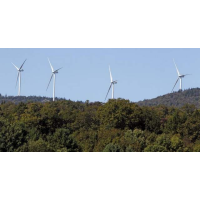Energy Distributions Can’t Keep up with Wind Energy Production
 Wind turbines in Vermont (photo: Toby Talbot, AP)
Wind turbines in Vermont (photo: Toby Talbot, AP)
Despite tremendous growth in wind energy capacity in the U.S., the antiquated energy distribution system is preventing wind from reaching its full potential—often forcing wind farms to throttle back on windy days. Although the technology to solve the problem has existed for years, foot-dragging by utility companies has left the U.S. ill-prepared to take advantage of wind and other renewable energy sources.
That’s becoming a bigger problem every year, as an alternative energy revolution continues to gather strength. In 2012, wind power was the biggest source (43%) of new energy capacity while its price neared an all-time low and total U.S. wind-generation capacity reached 60 gigawatts–5% of total production capacity, with more than twice that much (135 GW) in the pipeline.
But the young wind industry is being strangled by the low-tech power grid. “There hasn’t been a lot of investment in the grid for the last two decades,” explains Michael Goggin, a senior analyst at the American Wind Energy Association, diplomatically. “We just don’t have a strong grid that’s built out in the parts of the country where there are a lot of wind resources.”
David Blittersdorf, chief executive of AllEarth Renewables, which owns Georgia Mountain Community Wind in Vermont, is less reticent in placing blame. “We have a grid system that’s not smart—it’s kind of dumb, it’s a 100-year-old system—and they run it like fossils and nukes are the only things that matter and the rest of us, they can fiddle with,” he told The New York Times.
Because electricity is energy, its nature is to move and not to rest, and storage of electricity for later use in large quantities is so far impracticable. As a result, electricity must be used as soon as it is generated, and managers of the complex system of networks to distribute power from power plants to users—called the power grid—must match demand and supply in real time.
When the power grid was designed, electric power generation was dominated by large power plants burning fossil fuels or splitting atoms, and high capacity transmission lines were placed only near them. Wind farms, however, are typically located in sparsely populated areas or even off-shore, where high capacity lines do not exist. Bottlenecks also occur when more energy is being produced than the system can safely transport.
The result is called curtailment. In Vermont during last year’s record heat wave, for example, the grid operator curtailed the Kingdom Community Wind Farm to just one-third of the energy it could have produced, telling Green Mountain Power, which owns the wind plant, to use diesel powered units instead.
Governor Peter Shumlin (D) questioned whether grid operator ISO New England (ISO-NE) was really trying to use renewable energy as required by Vermont law. “Vermont has a clear preference for renewable resources and would have preferred that the local renewable energy produced by this utility-owned resource had been used,” wrote the governor. “I also urge ISO-NE to fully account for growing distributed generation renewable resources in its transmission planning assumptions; Vermont has seen a tremendous growth in these resources in the past few years and believes that growth will continue.”
But Ellen Foley, a spokeswoman for ISO-NE, says the infrastructure is to blame: “As these wind turbines are built and interconnected, they’re interconnecting to local transmission lines, and for the most part they can produce electricity and inject it onto the system. But there may be occasions where they may have to be backed down or curtailed because of the limitations of the line—it’s literally the size of the line.”
Gil Bindewald, a project manager at the U.S. Department of Energy, said solutions would take time and that “There is no silver bullet solution for effectively integrating renewable sources of energy such as wind onto the grid.”
Nevertheless, solving the grid bottleneck problem would serve as a powerful boost to the development of alternative energy, including wind. “There’s enough resource there to power the United States a dozen times over by conservative estimates,” claims Goggin. “A lot of that resource is concentrated in the middle of the country, far from where people live. There’s extremely cost-effective wind left out there. We just can’t tap it, because we haven’t built out the transmission system.”
In Vermont, meanwhile, Kingdom Community Wind Farm is installing $10 million in equipment that is supposed to even out the flow of energy and reduce curtailments, although grid officials have made no promises.
-Matt Bewig
To Learn More:
Newly Available Wind Power often has no Place to go (by Trevor Graff, McClatchy)
Intermittent Nature of Green Power Is Challenge for Utilities (by Diane Cardwell, New York Times)
Impact of Curtailment on Wind Economics (by Jonathan Cheszes, Renewable Energy World)
- Top Stories
- Unusual News
- Where is the Money Going?
- Controversies
- U.S. and the World
- Appointments and Resignations
- Latest News
- Trump to Stop Deportations If…
- Trump Denounces World Series
- What If China Invaded the United States?
- Donald Trump Has a Mental Health Problem and It Has a Name
- Trump Goes on Renaming Frenzy






Comments